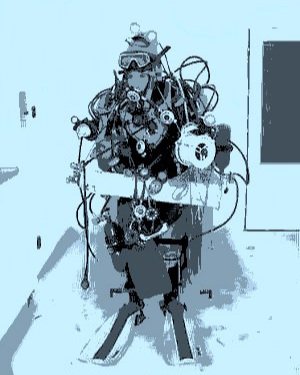The Redundancy Dilemma
/Necessity is the mother of all invention; however, there is a recurring predicament that transpires periodically. In our striving to extend limits comfortably, we have left ourselves vulnerable to something I call ‘gadget pandemonium’. It is true that redundancy is the basis from which we design any SCUBA configuration, be it a 20 meter (66 foot) dive or 100 meter (330 foot) dive. Yet this fundamental safety feature can also be a killer and the defence is not always so straightforward.
We are engaging in an era that is very exciting to the SCUBA industry. The vast improvements in diving equipment and training have opened doors to many divers. For years, technical and commercial divers have been experimenting with various equipment configurations, working to establish a unit that meets their needs, while still complying with all the required safety systems.
Today there is an overabundance of dive gear that is available to both recreational and extended range divers, allowing them to go deeper and longer while staying warm and safe. The ingenuity born within the technical community now benefits every diver worldwide. The result is an equipment modification routine based on redundancy.
Gadget Pandemonium
This principal has been adopted by all levels of the diving community to a certain degree (i.e. your octopus, safe second or alternate air source), but as divers continue to develop, they sometimes inundate themselves with equipment and are prone to task overloading and stress – thus defeating the whole purpose of redundancy, hence gadget pandemonium.
Necessity is the mother of all invention
An example of this is the basic inflation system for a deep diver. In an advanced decompression class I once taught, the issue of argon bottles and inflator systems became a topic of significant discussion. In addition to the standard gear, the equipment used by everyone in the course consisted of twin tanks on manifold, redundant bladder systems, stage bottle and argon. The concern was the number of extra inflator hoses strapped, wrapped and zip-tied everywhere. A diver wants to be able to switch to an air hose should his argon run out (we use argon back in the day before heated vests were a thing), inflate his lift bag and have a hose attached to his redundant bladder. The question was; how many hoses are actually needed?
Each diver is as different as is his equipment, dive plan and personal comfort levels, but we all must conform to a few very simple standards. It is easy to look good by loading gear all over your body and it is easy to dive to 91MSW (300FSW), the trick is coming back. My personal solution to the hose dilemma is as follows:
One hose is attached to my primary bladder inflator (on my left) and comes off my secondary first stage (on the left side of the manifold). Chances are a failure will occur on your primary first stage; in a valve shut down scenario, it is nice not to have to also switch inflators.
A second hose, which leads from my primary first stage (on the right side of the manifold) to my redundant bladder inflator (on my right side), is long enough to pop off and attach to my drysuit (nipple faces my right) should my argon quit or run out. This also eliminates hoses crossing behind my head and potentially snagging in overhead environments. On this hose I clip an inflator tool for my bag. At the beginning of a series of decompression stops, the redundant bladder is not likely to be needed.
A third hose feeds directly from my argon which hangs behind my right arm to my drysuit.
Depending on the dive, I may opt for a fourth hose strapped tightly to one of my stage bottles as a backup in the event I experience a catastrophic failure in my manifold at depth. This option is usually employed for dives deeper than 60MSW (200FSW). I also include this contingency in my required air supply calculations. On deep dives, one stage is reserved as a decompression gas and/or travel gas, and is used based on the rule of thirds. If it is the only stage I am carrying, it will have an inflator hose (this is a last option). The other stage bottle (if used) is a bailout of air (used for extremely deep dives or Rebreather dives) and will have the inflator hose connected to it as opposed to my deco supply.
My system can change from dive to dive, from one experience to the next. What does not change is the fact that I will not compromise on safety and that once I have chosen a configuration; I practice with it in controlled waters until I know it well.
When doing any equipment selection and modifications, ask yourself; Do I need it, and if so, what is the best way to put it together? Can I work with it? Take it into a controlled environment with a buddy and practice with it. Run through some emergency/problem scenarios like a gas shut down. Be sure it will be comfortable to dive with at depth and in current before diving deep or in current. Ask someone who is qualified and experienced to give you a hand; they can eliminate a lot of uncomfortable steps. Remember, the redundancy dilemma is sometimes subtle and unnoticeable.
~Safe Diving



